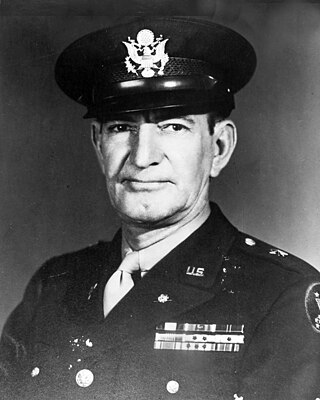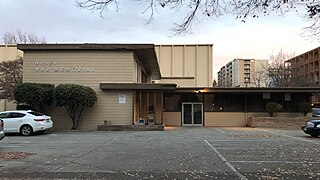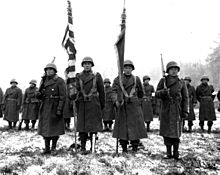
Sadao Munemori was a United States Army soldier and posthumous recipient of the Medal of Honor, after he sacrificed his life to save those of his fellow soldiers at Seravezza, Italy during World War II.

The 442nd Infantry Regiment was an infantry regiment of the United States Army. The regiment including the 100th Infantry Battalion is best known as the most decorated in U.S. military history and as a fighting unit composed almost entirely of second-generation American soldiers of Japanese ancestry (Nisei) who fought in World War II. Beginning in 1944, the regiment fought primarily in the European Theatre, in particular Italy, southern France, and Germany. The 442nd Regimental Combat Team (RCT) was organized on March 23, 1943, in response to the War Department's call for volunteers to form the segregated Japanese American army combat unit. More than 12,000 Nisei volunteers answered the call. Ultimately 2,686 from Hawaii and 1,500 from mainland U.S. internment camps assembled at Camp Shelby, Mississippi in April 1943 for a year of infantry training. Many of the soldiers from the continental U.S. had families in internment camps while they fought abroad. The unit's motto was "Go for Broke".

Go for Broke! is a 1951 black-and-white war film directed by Robert Pirosh, produced by Dore Schary and starring Van Johnson and six veterans of the 442nd Regimental Combat Team. The film co-stars Henry Nakamura, Warner Anderson, and Don Haggerty in its large cast.

The 100th Infantry Battalion is the only infantry unit in the United States Army Reserve. In World War II, the then-primarily Nisei battalion was composed largely of former members of the Hawaii Army National Guard. The 100th saw heavy combat during World War II, starting in September 1943 and continuing after being attached as a battalion of the Nisei 442nd Regimental Combat Team in June 1944. The unit was unofficially nicknamed the Purple Heart Battalion, with the motto "Remember Pearl Harbor".

The Go for Broke Monument in Little Tokyo, Los Angeles, California, commemorates Japanese Americans who served in the United States Army during World War II. It was created by Los Angeles architect Roger M. Yanagita whose winning design was selected over 138 other submissions from around the world.

The Japanese American Memorial to Patriotism During World War II is a National Park Service site to commemorate the contributions of American citizens of Japanese ancestry and their parents who patriotically supported the United States despite unjust treatment during World War II.

The Jerome War Relocation Center was a Japanese American internment camp located in southeastern Arkansas, near the town of Jerome in the Arkansas Delta. Open from October 6, 1942, until June 30, 1944, it was the last American concentration camp to open and the first to close. At one point it held as many as 8,497 detainees. After closing, it was converted into a holding camp for German prisoners of war. Today, few remains of the camp are visible, as the wooden buildings were taken down. The smokestack from the hospital incinerator still stands.

Young-Oak Kim was a United States Army officer during World War II and the Korean War and a civic leader and humanitarian. He was a member of the U.S. 100th Infantry Battalion and 442nd Regimental Combat Team, and a combat leader in Italy and France during World War II. He was awarded 19 medals, including the Distinguished Service Cross, two Silver Stars, two Bronze Stars, three Purple Hearts, a Bronze Medal of Military Valor, a Légion d'honneur, a Croix de Guerre, and (posthumously) the Korean Taeguk Cordon of the Order of Military Merit. After his military career, Kim dedicated his life to public service and was an active founder and leader of several non-profit organizations for underserved communities throughout Southern California. He died of cancer at the age of 86. In May 2016, members of the Congressional Asian Pacific American Caucus held a press conference, organized by the Council of Korean Americans, to call on President Barack Obama to posthumously award Kim the nation's highest civilian honor, the Presidential Medal of Freedom.
Allan Masaharu Ohata was a United States Army soldier. He is best known for receiving the Medal of Honor because of his actions in World War II.

Colonel Virgil Rasmuss Miller was a United States Army officer who served as Regimental Commander of the 442d Regimental Combat Team (RCT), a unit which was composed of "Nisei", during World War II. He led the 442nd in its rescue of the Lost Texas Battalion of the 36th Infantry Division, in the forests of the Vosges Mountains in northeastern France.

Kiyoshi K. Muranaga was a United States Army soldier and a recipient of the United States military's highest decoration—the Medal of Honor—for his actions in World War II.

The Military Intelligence Service was a World War II U.S. military unit consisting of two branches, the Japanese American unit and the German-Austrian unit based at Camp Ritchie, best known as the "Ritchie Boys". The unit described here was primarily composed of Nisei who were trained as linguists. Graduates of the MIS language school (MISLS) were attached to other military units to provide translation, interpretation, and interrogation services.

"The Lost Battalion" refers to the 1st Battalion, 141st Infantry, which was surrounded by German forces in the Vosges Mountains on 24 October 1944.

Japanese American history is the history of Japanese Americans or the history of ethnic Japanese in the United States. People from Japan began immigrating to the U.S. in significant numbers following the political, cultural, and social changes stemming from the 1868 Meiji Restoration. Large-scale Japanese immigration started with immigration to Hawaii during the first year of the Meiji period in 1868.
Susumu Ito was an American cell biologist and soldier born in Stockton, California. He was a Nisei, a second-generation Japanese American.

Brigadier General Kendall "Wooch" Jordan Fielder was an influential World War II officer in the United States Army, who served in Hawaii at the time United States' entry into World War II, and testified before Congress in favor of statehood.
Lyn Crost was a World War II correspondent and author.
The Nisei Soldiers of World War II Congressional Gold Medal is an award made for the Japanese American World War II veterans of the 100th Infantry Battalion, the 442nd Regimental Combat Team and the Military Intelligence Service. The Congressional Gold Medal is the most prestigious award given to civilians in the United States for achievements and contributions. The medal was approved by Congress under Public Law 111–254 in 2010 to honor the Japanese Americans who had served in the war. It was collectively presented on November 2, 2011.
The nine Nakada brothers were World War II soldiers of Japanese American descent who served in various roles. The Nakada family had more sons in the U.S. military than any other family during the war.

Nisei Memorial VFW Post 8985 was founded in 1947 by Japanese-American World War II veterans of the 442nd RCT and the Military Intelligence Service in Sacramento, California. Its members would form the first of 14 segregated Nisei VFW posts chartered in California. The post's clubhouse, originally built as a restaurant, was purchased with assistance from the local JACL in 1955, and is now the last remaining property associated with what was once Sacramento's historic Japantown.




























